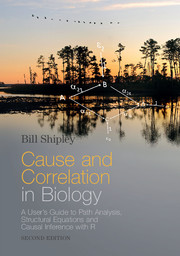 Cause and Correlation in Biology
Cause and Correlation in Biology Published online by Cambridge University Press: 05 April 2016
The shadow's cause
The Wayang Kulit is an ancient theatrical art, practised in Malaysia and throughout much of the Orient. The stories are often about battles between good and evil, as told in the great Hindu epics. What the audience actually see are not actors, nor even puppets, but, instead, the shadows of puppets projected onto a canvas screen. Behind the screen is a light. The puppet master creates the action by manipulating the puppets and props so that they will intercept the light and cast shadows. As these shadows dance across the screen the audience must deduce the story from these two-dimensional projections of the hidden three-dimensional objects. However, shadows can be ambiguous. In order to imply the three-dimensional action, the shadows must be detailed, with sharp contours, and they must be placed in context.
Biologists are unwitting participants in nature's shadow play. These shadows are cast when the causal processes in nature are intercepted by our measurements. Like the audience at the Wayang Kulit, the biologist cannot simply peek behind the screen and directly observe the actual causal processes. All that can be directly observed are the consequences of these processes in the form of complicated patterns of association and independence in the data. As with shadows, these correlational patterns are incomplete – and potentially ambiguous – projections of the original causal processes. As with shadows, we can infer much about the underlying causal processes if we can learn to study their details and sharpen their contours, especially if we can study them in context.
Unfortunately, unlike the puppet master in a Wayang Kulit, who takes care to cast informative shadows, nature is indifferent to the correlational shadows that it casts. This is the main reason why researchers go to such extraordinary lengths to randomise treatment allocations and to control variables. These methods, when they can be properly done, simplify the correlational shadows to manageable patterns that can be more easily mapped onto the underlying causal processes.
It is uncomfortably true, though rarely admitted in statistics texts, that many important areas of science are stubbornly impervious to experimental designs based on the randomisation of treatments to experimental units.
To save this book to your Kindle, first ensure no-reply@cambridge.org is added to your Approved Personal Document E-mail List under your Personal Document Settings on the Manage Your Content and Devices page of your Amazon account. Then enter the ‘name’ part of your Kindle email address below. Find out more about saving to your Kindle.
Note you can select to save to either the @free.kindle.com or @kindle.com variations. ‘@free.kindle.com’ emails are free but can only be saved to your device when it is connected to wi-fi. ‘@kindle.com’ emails can be delivered even when you are not connected to wi-fi, but note that service fees apply.
Find out more about the Kindle Personal Document Service.
To save content items to your account, please confirm that you agree to abide by our usage policies. If this is the first time you use this feature, you will be asked to authorise Cambridge Core to connect with your account. Find out more about saving content to Dropbox.
To save content items to your account, please confirm that you agree to abide by our usage policies. If this is the first time you use this feature, you will be asked to authorise Cambridge Core to connect with your account. Find out more about saving content to Google Drive.